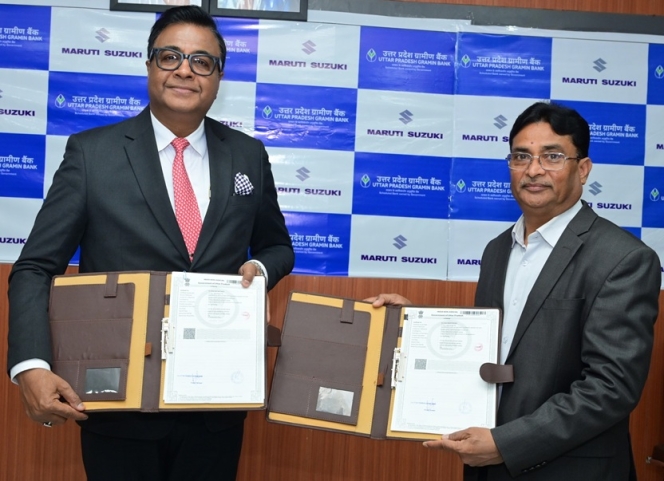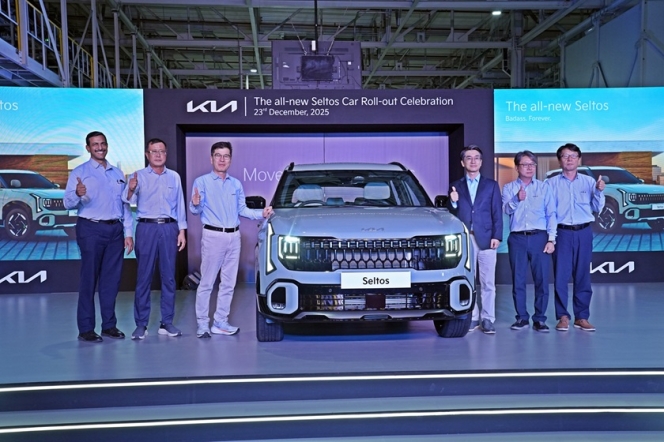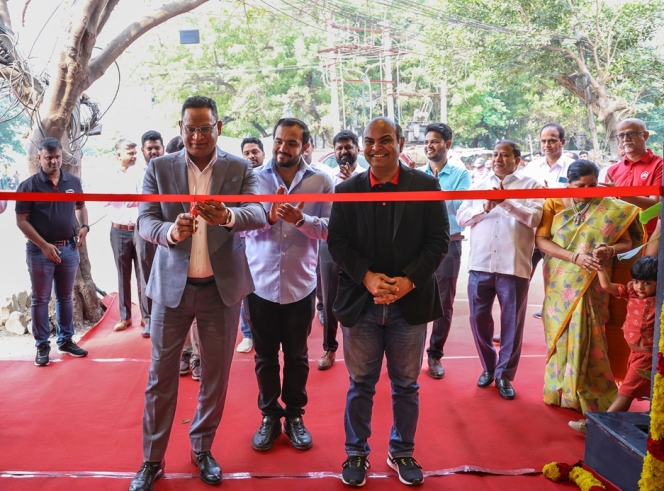MINI India Launches Three New Models In India
- By MT Bureau
- June 22, 2021

MINI India has launched the all-new MINI 3-Door Hatch, MINI Convertible and the MINI John Cooper Works Hatch in India. The new MINIs will only be available as Completely Built-up Units (CBUs) in their petrol guise.
MINI 3-Door Hatch and MINI Convertible:
The exterior of the new MINIs has been simplified and modernised with a new characteristic hexagonal radiator grille and the round hallmark MINI LED headlights with integrated fog lights. The car's side view is dominated by the striking new contours of the wheel arch surrounds and the redesigned side scuttles with integrated LED side indicators.
At the rear, the car continues to carry the British flag-inspired rear light graphics along with a new narrow LED rear fog light integrated into the rear apron.
The MINI 3-Door Hatch and the Convertible will be available in rooftop Grey metallic, Island Blue metallic, Enigmatic Black and Zesty Yellow (only for MINI Convertible) colour options. Users can also opt for a piano black exterior package that gets the door handles, side scuttles, fuel cap, MINI logos on the bonnet and luggage compartment lid, the model lettering and tailpipes of the exhaust system finished in high-gloss black.
Along with the standard colour options, customers can also choose Jet Black, Aspen White, Melting Silver paintwork (for MINI 3-Door Hatch and Convertible) and a unique colour gradient from San Marino Blue through Pearly Aqua to Jet Blackcontrasting roof colour.
MINI has renewed the 17-inch light-alloy wheels with options for Roulette Spoke-Two-Tone, Tentacle Spoke-Black and Rail Spoke-Two-Tone.
On the inside, the MINIs offers two packages:
- MINI Interior Surfaces Silver Chequered features sporty style wherein the instrument panel surface and the elliptical ring in the door are finished in chequered design.
- MINI Interior Surfaces Aluminium features opposing diagonal lines representing a modern, visually impactful evolution of the classical herringbone design.
MINI offers two new standard upholstery options: Cloth-leatherette combination in Black Pearl Light Chequered and Black Pearl Carbon Black. In addition, customers can spec their upholstery using the MINI Yours Leather Lounge in Carbon Black, Leather Cross Punch in Carbon Black, Leather Chester in Satellite Grey and Malt Brown.
MINI has given the car a new multifunction steering wheel design integrating more functions into fewer control surfaces. The audio control unit and the function buttons for hazard warning lights and driver assistance systems are integrated into the central 8.8-inch central colour touchscreen system. MINI also offers the circular touchscreen system, touch-sensitive buttons and piano black finishes as standard on the new cars.
Customers also can add a 5-inch multifunctional instrument display on the steering column to improve the cockpit feeling. Other additions include MINI Wired Package (adds navigation system, wireless charging, enhanced Bluetooth mobile preparation), MINI Excitement Pack (adds LED interior and ambient lighting that illuminates the cockpit with a choice of selectable colours as well as a projection of the MINI logo from the exterior mirror on the driver's side when opening and closing the car door) and an upgrade to Harman Kardon hi-fi speaker system.
In terms of performance, the MINIs are powered by the latest 2.0 l MINI TwinPower Turbo Technology mated to a 7-Speed Double Clutch Steptronic Transmission. The twin-turbo engine makes 192 hp of power and a torque of 280 Nm sufficient to propel the car from 0-100 km/h in just 6.7 seconds for the 3-Door Hatch and 7.1 seconds for the Convertible.
In terms of safety, MINI has equipped all three models with front passenger airbags, Brake Assist, 3-Point Seat Belts, Dynamic Stability Control, Crash Sensor, Anti-lock Braking System, Cornering Brake Control, Run-flat tyres and Rear-View Camera as standard along with Rollover Protection System for the Convertible.
MINI John Cooper Works (JCW) Hatch:
The changes on the new JCW Hatch include a new hexagonal front grille with a honeycomb pattern and a cross member at the bottom edge finished in red. The JCW Hatch also features the exclusive John Cooper Works bonnet stripes that provide a distinct race-inspired look to the car,
In terms of the exterior and interiors options, the JCW Hatch gets all the standard options from the 3-Door Hatch and the Convertible and some more, including the exclusive Chilli Red paint colour, the upgraded JCW sports seats in dinamica.
In terms of the mechanicals, the car gets the same 2.0l MINI TwinPower Turbo Technology engine mated to an 8-Speed Steptronic Sports Transmission. The JCW MINI produces 231 hp of power with 320 Nm torque helping it complete the 0-100 km/h sprint in just 6.1 sec.
The CBU MINIs cost:
3-Door Hatch: INR 38 lakh (ex-showroom)
Convertible: INR 44 lakh (ex-showroom)
JCW Hatch: INR 45.5 lakh (ex-showroom) (MT)
Citroen India Delivers 51 C3 CNG Vehicles To Luthra Group
- By MT Bureau
- December 24, 2025
Citroen India, in partnership with its dealership La Maison Nanavati, has completed the handover of 51 Citroen C3 CNG vehicles to the Luthra Group. The ceremony took place at the Luthra Group’s headquarters in Surat.
The delivery is part of Citroen's strategy to expand its presence in tier-II and tier-III markets by providing mobility solutions to businesses and individuals.
The Citroen C3 CNG is designed for high-usage environments and daily commutes. The model includes several features tailored for the Indian market, integration of a factory-fitted CNG kit to manage running costs. A suspension system tuned specifically for local road conditions. Provisions for cabin space and air-conditioning systems designed for high-ambient temperatures.
The handover to Luthra Group represents the brand's focus on cost-efficient transportation. By targeting the regional business sector, Citroen India aims to strengthen its footprint in Gujarat and the broader Indian mobility market.
The C3 CNG is positioned as a solution for users requiring reliability and low operating expenses without compromising on ride comfort.
Maruti Suzuki India Partners Uttar Pradesh Gramin Bank For Retail Financing
- By MT Bureau
- December 24, 2025

Maruti Suzuki India has signed a Memorandum of Understanding (MoU) with Uttar Pradesh Gramin Bank, a regional rural bank, for vehicle retail financing partnership on new cars, pre-owned vehicles and commercial vehicles.
This collaboration marks the 50th retail finance partner for Maruti Suzuki India. The partnership is intended to use the bank’s network to provide credit options to a range of customer profiles, particularly in rural and semi-urban regions.
The partnership aims to increase the accessibility of Maruti Suzuki products through, tailored finance schemes designed for rural and regional customers.
Partho Banerjee, Senior Executive Officer, Marketing & Sales, Maruti Suzuki India, said, “Our partnership with Uttar Pradesh Gramin Bank marks a significant milestone as we onboard our 50th retail finance partner. This reinforces our commitment to making car ownership simpler and more affordable for customers across India. By expanding our reach through this strategic alliance, we aim to empower buyers with competitive, customer-friendly financing solutions that enhance the overall purchase experience. We remain focused on delivering seamless, tailored finance options, and this collaboration strengthens our vision of providing the Joy of Mobility to aspiring Indian consumers.”
Yadav S. Thakur, Chairman, Uttar Pradesh Gramin Bank, said, “At Uttar Pradesh Gramin Bank, empowering customer aspirations is at the heart of everything we do. Our partnership with Maruti Suzuki, a leader in the automotive industry, is a strategic step towards enhancing our service offerings and delivering greater value to our customers. This collaboration aligns with our 'Customer-First' mission, enabling us to provide accessible and affordable vehicle financing solutions. We look forward to helping more individuals and families across the country realise their dream of owning a Maruti Suzuki vehicle.”
Kia India Commences Production Of New Seltos In Anantapur
- By MT Bureau
- December 23, 2025

Kia India has started production of the latest generation Seltos at its manufacturing facility in Anantapur. The company has confirmed that prices for the mid-SUV will be announced on 2 January 2026.
The Anantapur plant, established in 2019, serves as a hub for both the Indian domestic market and international exports. The facility uses automation and a local workforce to manufacture the Seltos, which was the first model produced by the company in India.
The new model is built on Kia’s K3 platform, which has been engineered to increase structural rigidity and improve suspension damping. The vehicle has grown in size compared to its predecessor to increase cabin space and stability. It has 4,460 mm of length, 1,830 mm of width and a wheelbase of 2,690 mm.
The exterior design follows the ‘Opposites United’ philosophy, featuring a ‘Digital Tiger Face,’ LED projection headlamps, and alloy wheels with neon brake callipers.
The vehicle integrates several digital interfaces and driver assistance systems. It features an upgraded Kia Connect 2.0 suite with over-the-air (OTA) software updates and a proximity unlock function.
In terms of safety, it gets 24 features as standard, while ADAS Level 2 offers 21 autonomous features to assist the driver. The Kia Seltos SUV comes with three engine options – 1.5-litre Petrol producing 115 PS of power and 144 Nm of torque, 1.5 T-GDI Petrol producing 160 PS of power and 253 Nm of torque and a 1.5-litre diesel engine producing 116 PS of power and 250 Nm of torque.
Transmission choices include a 6-speed manual (6MT), intelligent manual (6iMT), IVT, 7-speed dual-clutch (7DCT) and a 6-speed automatic (6AT). The model will be sold in four trims – HTE, HTK, HTX and GTX – with additional option variants and an X-Line styling pack.
Gwanggu Lee, Managing Director & CEO, Kia India, said, “The roll-out of the All-New Kia Seltos marks a proud milestone for Kia India. Seltos has long set benchmarks in the mid-SUV segment, and this new generation represents a bigger, bolder, and more progressive evolution shaped by insights from Indian customers. With production now underway at our Anantapur facility, our teams are fully geared to ensure customers can take delivery of their all-new Seltos without long waiting periods. We are confident the all-new Seltos will once again redefine expectations in the segment and strengthen Kia’s leadership in India."
“The new Seltos looks fantastic. The Anantapur team, together with our supplier partners, have done an outstanding job in delivering our customers a great looking, significantly bigger, technologically progressive and safe vehicle with impressive functionality and connectivity,” he said.
- Citroen India
- Jeep
- Stellantis
- Citroen 2.0
- Shailesh Hazela
- Kumar Priyesh
- Sree Venkata Teja Kethineni
- VTK Automobiles
Citroen India Opens 126th Outlet In Chennai Under Citroen 2.0 Strategy
- By MT Bureau
- December 23, 2025

Stellantis-owned French automotive brand Citroen India has inaugurated its 126th point of sales and service (POS&S) facility in Chennai, continuing the expansion of its network under the ‘Citroen 2.0 – Shift Into The New’ strategy.
The new 3S (Sales, Service and Spares) facility is located at Chitlapakkam, near Chrompet. It is an extension of the partnership with VTK Automobiles, which now operates five Citroen touchpoints in the city. The outlet functions as a ‘Stellantis Brand House,’ allowing customers to access both Citroen and Jeep brands within a single space.
Since the announcement of the Citroen 2.0 strategy, the brand has increased its network by 48.6 percent. Over the last six months, the company added 43 points of sale through its network expansion programmes. Citroen expects to reach a total of 135 outlets by the end of the year, with further operations planned for the north, west, and east of India.
The strategy focuses on several pillars – deepening the domestic supply chain for India-centric products. Expanding the dealer footprint into Tier 2 and Tier 3 locations. Using digital tools and unified spaces for sales and aftersales services.
Shailesh Hazela, CEO and Managing Director, Stellantis India, said, “The expansion of Stellantis network further with VTK dealership in Chennai marks another important step in Citroen and Jeep India’s network growth strategy. Chennai is a key market for us, and this upgraded facility will enable us to serve our customers better with a seamless sales and ownership experience. Aligned with our Citroen 2.0 strategy, we remain committed to strengthening our dealer partnerships and building a robust, customer-centric network across the country.”
Kumar Priyesh, Director Automotive Brands, Stellantis India, said, “We have grown our network by almost 48.6 percent since we announced the Citroen 2.0 strategy and have been able to expand our operations in different parts of country: adding tier 2/3 locations while further strengthening in Metro/ Tier 1 cities. Through project Visitar, Network Expansion Program and expansion in new geographies we added over 43 POS in the last 6 months and are already in advanced stages to start additional operations in North, West and Eastern parts of the country and expected to close the year with 135 POS for Citroen.”
Sree Venkata Teja Kethineni, Dealer Principal, VTK Automobiles, said, “We’re happy to partner to this pivotal shift in automotive retail, proudly representing Jeep and Citroen. Our dual-brand strategy empowers us to deliver a truly elevated and distinctive experience – whether customers seek rugged performance or refined sophistication. With passion, professionalism and personalised care at the core, our team is committed to exceeding expectations and upholding the global standards these iconic brands represent.”
The facility includes a service centre equipped with diagnostics and digital tools. Staff members are trained across both Jeep and Citroen product lines to provide technical support and product information.






Comments (0)
ADD COMMENT